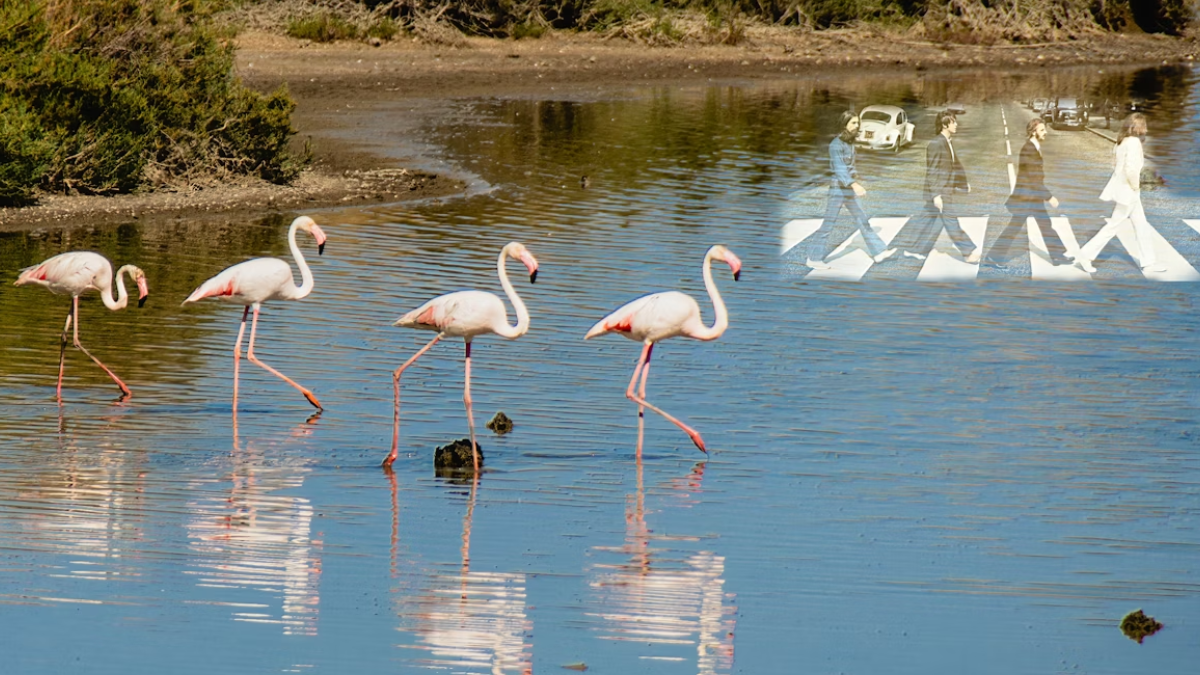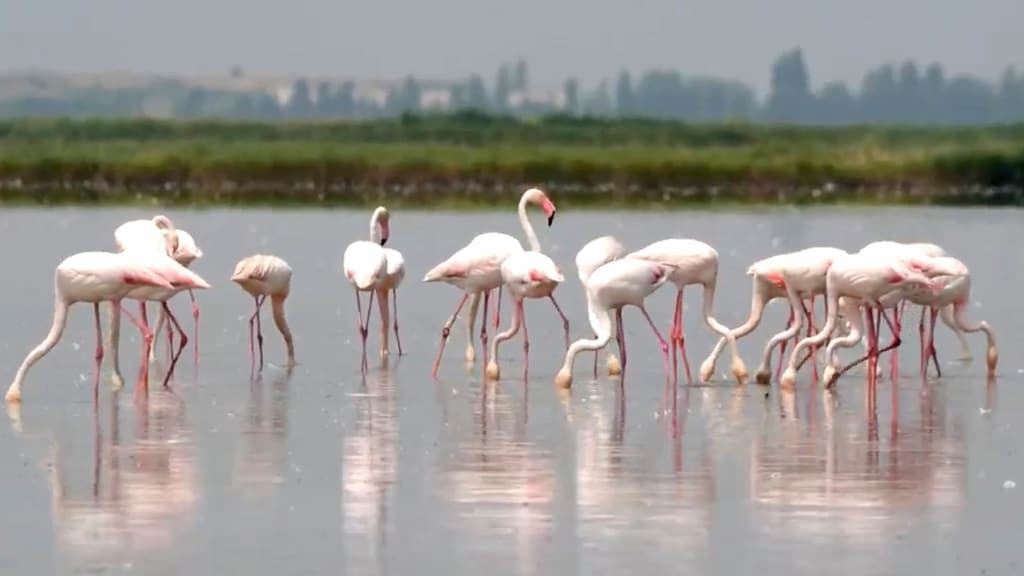An artificial pond in Afyonkarahisar, #Turkey, which was initially created to store wastewater but has become a new habitat for flamingos and various other migratory bird species.
Photograph: Anadolu/Getty Images
An artificial pond in Afyonkarahisar, #Turkey, which was initially created to store wastewater but has become a new habitat for flamingos and various other migratory bird species.
Photograph: Anadolu/Getty Images
Flock of flamingos apron half flamingo flamingoes 3 pockets lined cotton server waiter strawberry handmade 15" L 21" W ready to ship
Friends of a Feather Flock Together
Great Egret and Flamingos
Saint Louis Zoo
Saint Louis, Missouri, USA
#İtalya’da risotto pirinci flamingoların tehdidi altında!
Çiftçiler ürün kayıpları yaşıyor #SonDakika #Pirinç #Flamingo
https://cevrehatti.com/surdurulebilirlik/italyada-risotto-pirinci-flamingolarin-tehdidi-altinda/

𝗙𝗹𝗮𝗺𝗶𝗻𝗴𝗼'𝘀 𝘃𝗲𝗿𝘄𝗼𝗲𝘀𝘁𝗲𝗻 𝗿𝗶𝘀𝗼𝘁𝘁𝗼-𝗼𝗼𝗴𝘀𝘁 𝗶𝗻 𝗜𝘁𝗮𝗹𝗶ë, 𝗯𝗼𝗲𝗿𝗲𝗻 𝘄𝗮𝗻𝗵𝗼𝗽𝗶𝗴
Flamingo's zijn neergestreken in het noordoosten van Italië, en dat drijft boeren tot waanzin. De roze vogels verpesten de risotto-oogst doordat ze in de rijstvelden zoeken naar algen en insecten.

The Flamingo Garden in our backyard is named in honor of friends Ann, who gave me the flamingos, and Joan, who didn't. #flamingo #flamingogarden #garden #gardener #gardening #pennsylvaniagarden #pennsylvaniagardens #yucca #yuccas #butterflybush #butterflybushes #pussywillow
A Sprinkle of JoyousJoyness
Soooo cute, the pitter pats!
Have a JoyousJoyfulJoyness day!
Happy Pink Flamingo Day! Originally started to honor Don Featherstone who created the original lawn flamingo in 1957, it's a great day to celebrate the real bird as well.
Enjoy these pink flamingo knitting patterns and more on my flamingo post (including clothes for lawn flamingos!)
https://intheloopknitting.com/flamingo-knitting-patterns.php
5-16-24 Sketch Daily: Flamingo / Refreshing / Mermay
Tuz Gölü'nde yüzlerce flamingo ölü olarak bulundu: Aksaray, Ankara ve Konya sınırlarında yer alan ve son yıllarda kuraklıkla sıklıkla gündeme gelen Tuz Gölü'nde kuraklıkla birlikte ölü flamingolar da görüntülendi.
Allı turna olarak da bilinen flamingoların kuluçkaya yattığı en önemli sulak alanlar arasında yer alan Tuz Gölü'nde bugünlerde yüzlerce flamingo ölmüş olarak bulundu.
Kuluçkaya yatmak için… https://www.eshahaber.com.tr/haber/tuz-golu-nde-yuzlerce-flamingo-olu-olarak-bulundu-234210.html?utm_source=dlvr.it&utm_medium=mastodon EshaHaber.com.tr #TuzGölü #Flamingo #Kuraklık #Doğa #Çevre
Definitely not a nice man!
Loch Lomond #Flamingo Land tycoon backed #Reform UK and donated £162,500 to the #Tories.
https://www.dailyrecord.co.uk/news/politics/loch-lomond-flamingo-land-tycoon-35396293

I drew a flamingo person
This linocut shows a flamboyance of flamingos. The collective noun for a group of flamingos is a "Flamboyance". Isn't that perfect? And, ridiculously fun to say? Try it: "A flamboyance of flamingos." Alliterative, apt, succinct, this flaboyance of three pink and fuchsia flamingos are a chorus line of long-legged aquatic birds about to break out into a can-can routine.
Poetic is the elegance of art
#Flamingo #Tamarac
#Recreation #Vibrant
#Composure #Visual
#Angle #Picturesque
#Sculpture #Creative
Flamingo Fluid Dynamics, Part 2: The Game’s a Foot
Yesterday we saw how hunting flamingos use their heads and beaks to draw out and trap various prey. Today we take another look at the same study, which shows that flamingos use their footwork, too. If you watch flamingos on a beach, in muddy waters, or in a shallow pool, you’ll see them shifting back and forth as they lift and lower their feet. In humans, we might attribute this to nervous energy, but it turns out it’s another flamingo hunting habit.
As a flamingo raises its foot, it draws its toes together; when it stomps down, its foot spreads outward. This morphing shape, researchers discovered, creates a standing vortex just ahead of its feet — right where it lowers its head to sample whatever hapless creatures it has caught in this swirling vortex. And the vortex, as shown below, is strong enough to trap even active swimmers, making the flamingo a hard hunter to escape. (Image credit: top – L. Yukai, others – V. Ortega-Jimenez et al.; research credit: V. Ortega-Jimenez et al.; submitted by Soh KY)
Flamingo Fluid Dynamics, Part 1: A Head in the Game
Flamingos are unequivocally odd-looking birds with their long skinny legs, sinuous necks, and bent L-shaped beaks. They are filter-feeders, but a new study shows that they are far from passive wanderers looking for easy prey in shallow waters. Instead, flamingos are active hunters, using fluid dynamics to draw out and trap the quick-moving invertebrates they feed on. In today’s post, I’ll focus on how flamingos use their heads and beaks; next time, we’ll take a look at what they do with their feet.
Feeding flamingos often bob their heads out of the water. This, it turns out, is not indecision, but a strategy. Lifting its flat upper forebeak from near the bottom of a pool creates suction. That suction creates a tornado-like vortex that helps draw food particles and prey from the muddy sediment.
When feeding, flamingos will also open and close their mandibles about 12 times a second in a behavior known as chattering. This movement, as seen in the video above, creates a flow that draws particles — and even active swimmers! — toward its beak at about seven centimeters a second.
Staying near the surface won’t keep prey safe from flamingos, either. In slow-flowing water, the birds will set the upper surface of their forebeak on the water, tip pointed downstream. This seems counterintuitive, until you see flow visualization around the bird’s head, as above. Von Karman vortices stream off the flamingo’s head, which creates a slow-moving recirculation zone right by the tip of the bird’s beak. Brine shrimp eggs get caught in these zones, delivering themselves right to the flamingo’s mouth.
Clearly, the flamingo is a pretty sophisticated hunter! It’s actively drawing out and trapping prey with clever fluid dynamics. Tomorrow we’ll take a look at some of its other tricks. (Image credit: top – G. Cessati, others – V. Ortega-Jimenez et al.; research credit: V. Ortega-Jimenez et al.; submitted by Soh KY)